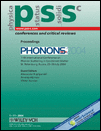Transmission and dispersion modes in phononic crystals with hollow cylinders: application to waveguide structure
Abstract
In this paper, we present a theoretical analysis of the propagation of acoustic waves through phononic crystals constituted of square array of hollow cylinders of steel immersed in water. The study of the transmission along the principal high-symmetry direction, ΓX of the Brillouin zone reveals the presence of a Narrow Pass Band (NPB) falling inside a wide band gap. Nevertheless the band structure displays two NPB in the same frequency range. Symmetry arguments, based on the calculation of the displacement field, shows that only the lowest NPB contributes to the transmission. The two NPB transform into two wider bands along the ΓM direction of the Brillouin zone, but now only the highest branch contributes to the transmission when a normally incident wave is launched onto the phononic crystal. Finally, we show that, by inserting hollow cylinders as a line defect inside a phononic crystal of filled steel cylinders, one can realize selective frequency waveguides that may be useful for guiding and multiplexing applications. (© 2004 WILEY-VCH Verlag GmbH & Co. KGaA, Weinheim)




